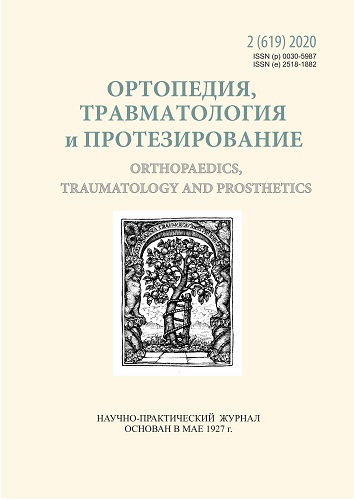Analysis of the nature and severity of injuries in patients with traumatic lesions of the brachial plexus
DOI:
https://doi.org/10.15674/0030-59872020240-47Keywords:
brachial plexus injury, supraclavicular, retroclavicular and subclavicular lesions, risk group for brachial plexus injuriesAbstract
Brachial plexus lesions (BPL) is a severe, disabling pathology is mostly occur in young patients of working age. Often, BPL is combined with other injuries, which significantly aggravate the diagnosis, and therefore delay the start of treatment. Objective: to analyze the characteristics of injuries in patients with traumatic BPI, that has been surgically treated at our center. Methods: retrospective analysis of 237 patients was performed, study included only patients with traumatic brachial plexus injuries, that has been surgically treated at our center, from 2000 to 2019. All patients underwent a thorough anamnesis, orthopedic-neurological examination, radiography, ultrasound, CT, MRI, NCS, ENMG. Particular attention was paid to the etiology, anatomical localization of the lesion, and presence of associated lesions. Results: 84.4 % of patients with BPL had other injuries. In patients of the younger age group (up to 50 y. o.) among the causes of this injury prevailed motorcycle road-traffic accident with root lesions, while in patients after the age of 50 y. o. — fell with injury at the level of cords. Root avulsions are characterized by high energy trauma, while lesions of the brachial plexus cords result from low-energy trauma. Most characteristic of the preganglionic injuries of the brachial plexus were their combination with traumatic brain injury and chest injuries, while for the injury at the level of cords were humerus fractures. Retroclavicular injuries (injury at the devisions level) were characterized by both combination of closed traumatic brain injury and fractures of clavicle and humerus. Conclusions: Most common BPL occur in three critical zones: preganglionic — 36.3 %, subclavicular — 35.4 %, and retroclavicular — 20.3 %. Risk group of patients with BPL should include patients with polytrauma, patients who had injuries traffic accident, falling or significant upper extremity traction.References
- Kaiser, R., Waldauf, P., Ullas, G., & Krajcová, A. (2018). Epidemiology, etiology, and types of severe adult brachial plexus injuries requiring surgical repair: Systematic review and meta-analysis. Neurosurgical Review, 43(2), 443-452. doi: 10.1007/s10143-018-1009-2
- Rasulić, L., Savić, A., Lepić, M., Puzović, V., Karaleić, S., Kovačević, V., … Samardžić, M. (2018). Epidemiological characteristics of surgically treated civilian traumatic brachial plexus injuries in Serbia. Acta Neurochirurgica, 160(9), 1837-1845. doi: 10.1007/s00701-018-3640-7
- Jain, D. K., Bhardwaj, P., Venkataramani, H., & Sabapathy, S. R. (2012). An epidemiological study of traumatic brachial plexus injury patients treated at an Indian centre. Indian Journal of Plastic Surgery, 45(03), 498-503. doi: 10.4103/0970-0358.105960
- Siqueira, M. G., & Martins, R. S. (2011). Surgical treatment of adult traumatic brachial plexus injuries: An overview. Arquivos de Neuro-Psiquiatria, 69(3), 528-535. doi: 10.1590/s0004-282x2011000400023
- Bhandari, P., Bhatoe, H., Mukherjee, M., & Deb, P. (2012). Management strategy in post traumatic brachial plexus injuries. The Indian Journal of Neurotrauma, 9(1), 19-29. doi: 10.1016/j.ijnt.2012.04.010
- Asplund, M., Nilsson, M., Jacobsson, A., & Von Holst, H. (2009). Incidence of traumatic peripheral nerve injuries and amputations in Sweden between 1998 and 2006. Neuroepidemiology, 32(3), 217-228. doi: 10.1159/000197900
Downloads
How to Cite
Issue
Section
License
Copyright (c) 2020 Serhii Strafun, Andrii Lysak

This work is licensed under a Creative Commons Attribution 4.0 International License.
The authors retain the right of authorship of their manuscript and pass the journal the right of the first publication of this article, which automatically become available from the date of publication under the terms of Creative Commons Attribution License, which allows others to freely distribute the published manuscript with mandatory linking to authors of the original research and the first publication of this one in this journal.
Authors have the right to enter into a separate supplemental agreement on the additional non-exclusive distribution of manuscript in the form in which it was published by the journal (i.e. to put work in electronic storage of an institution or publish as a part of the book) while maintaining the reference to the first publication of the manuscript in this journal.
The editorial policy of the journal allows authors and encourages manuscript accommodation online (i.e. in storage of an institution or on the personal websites) as before submission of the manuscript to the editorial office, and during its editorial processing because it contributes to productive scientific discussion and positively affects the efficiency and dynamics of the published manuscript citation (see The Effect of Open Access).














